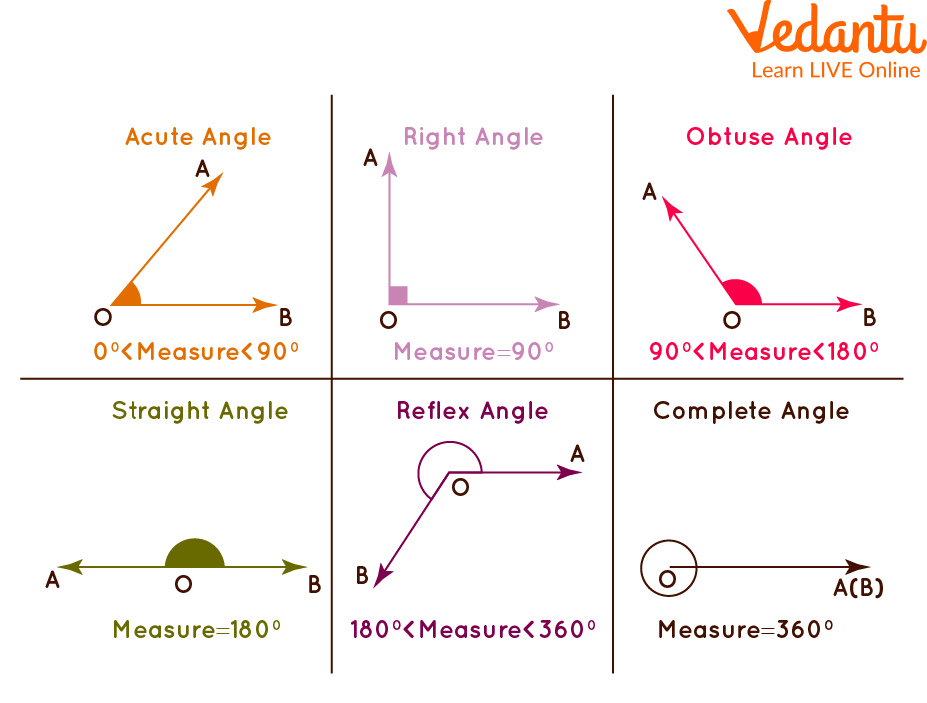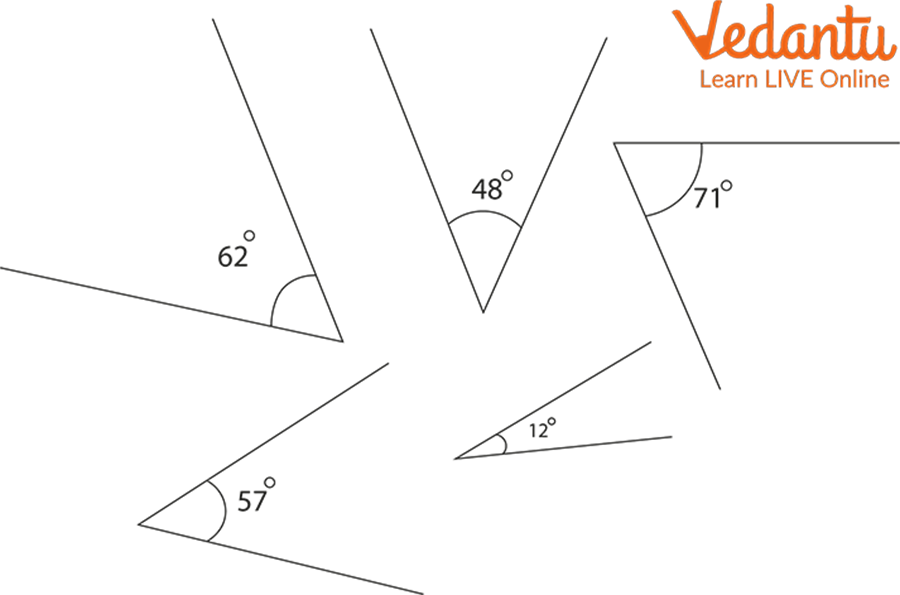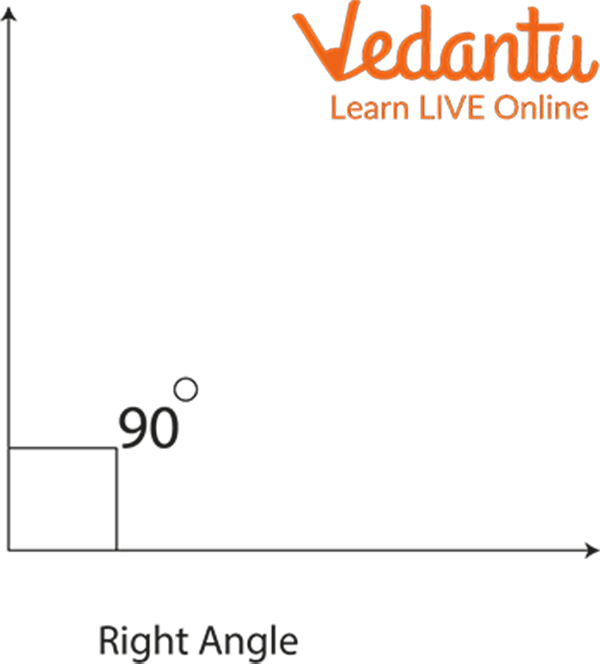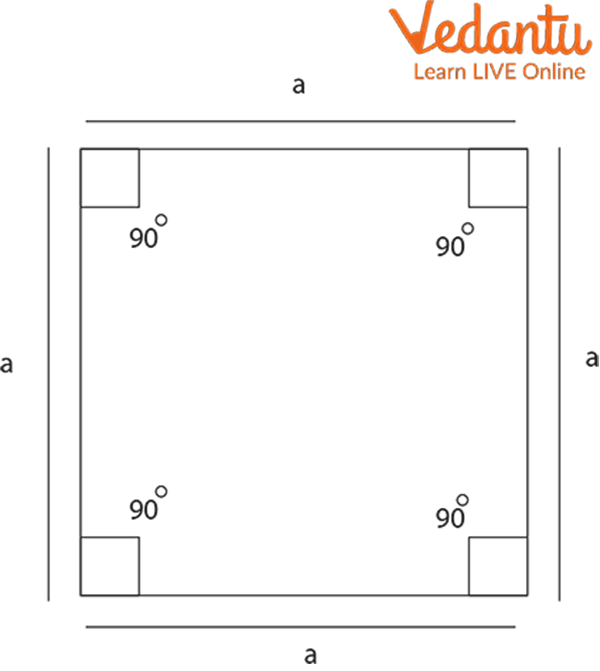




Key Types of Angles and Figures Explained
Angles are formed when two lines intersect at a point. The measure of the 'opening' between these two rays is called an 'angle'. Angles in Mathematics are measured when we need to find the inclination of a line with respect to another line or to describe the various types of figures in geometry. We always measure the angle in an anticlockwise direction from the x-axis but if we measure the angle in a clockwise direction the measure will be equal to $180^{\circ}-\mathrm{a}$ where a is the measure in a clockwise direction. In this article, we will learn about types of angles in Maths and also the different types of figures.
What are Angles?
Angle is the measure of the inclination of a line concerning another line or an axis. The inclination of a line is always measured in an anticlockwise direction from an axis. The angle is measured in degrees and radians represented by $\left({ }^{\circ}\right)$ and $(\mathrm{rad})$ respectively. Every time two lines or two line segments intersect, it forms an angle with the other line, and two pairs of vertically opposite angles form. Let us understand this concept of angle with the help of a figure:

Angles
Types of Angles in Maths
Angles can be classified into 3 types and they are right angle, acute angle, and obtuse angle.
Let us understand each one of these in significant detail:
Acute angle: The angle which has its measures less than 90⁰ or any angle which is less than 90⁰ is known as the acute angle.

Obtuse Angle: The angle which measures more than 90⁰ or any angle which is more than 90⁰ is known as an obtuse angle.

Obtuse Angle
Right Angle: The angle which has a measure of 90⁰ is known as the right angle.

Right Angle
What are Figures?
Figures in a plane are said to be plane figures. It means if a figure can be drawn in a single plane then it is said to be the plane figure. There are various geometrical figures in Mathematics. To form a figure, a minimum of three lines are required. By varying the angle and increasing the number of sides, different plane figures are obtained namely square, rectangle, pentagon, hexagon, etc.
Different Plane Figures
Square: It is a plane figure which has four sides and all four sides are equal in length. The area of the square is given by squaring the length of one of its sides i.e.,
Area $=(\text { Side })^2$
The perimeter of the square is $=4 \times$ the Length of one side.

Square
Rectangle: It is a plane figure which has four sides but the length of opposite sides is equal and length of adjacent sides is unequal.
The area of the rectangle is $=$ Length $(\mathrm{I}) \times$ Breadth $(\mathrm{b})$
The perimeter of the rectangle is the sum of all four sides i.e.,
$=2 \mathrm{l}+2 \mathrm{b}$
$=2(l+b)$

Rectangle
Triangle: It is a plane figure which has three sides.
The area of triangle is = \[\frac{1}{2}\] x base x hieght
The perimeter of the triangle is = Sum of the length of all the three sides

Triangle
Parallelogram: It is a plane figure which is bounded by four sides and the opposite sides are parallel and equal but the vertex angle is not equal to 90⁰ which is in the case of square and rectangle.
The parallelogram which has all the sides equal is known as Rhombus.
Area of Rhombus $=\dfrac{1}{2} \times d_1 \times d_2$;
where $d_1$ and $d_2$ are the two diagonals of the rhombus.
If the adjacent sides of the parallelogram are parallel and equal then the area = base × altitude; where the base is one of the sides of the parallelogram and altitude is the perpendicular distance between the base and the opposite sides.

Rhombus and Parallelogram
Circle: It is a plane figure which is represented as below:

Area of circle $=\pi r^2$
The perimeter of the circle is $=2 \pi r$; where $r$ is the radius of the circle and the value of $\pi$ is taken to be $3.14$ or $\dfrac{22}{7}$.
Solved Examples
Q1. Find the value of the missing angle in the following figure:

Missing Angle
Ans: We know that the sum of angles in a triangle is $180^{\circ}$.
Let the unknown angle be $x$.
Now, according to the question,
$x^0+50^{\circ}+55^{\circ}=180^{\circ}$
$\Rightarrow x^0+105^{\circ}=180^{\circ}$
$\Rightarrow x^0=180^{\circ}-105^{\circ}$
$\Rightarrow x^0=75^{\circ}$
Q2. Calculate the area and perimeter of the triangle whose base is 56 units and height is 32 units and the length of the third side is 62 units.
Ans: Given, the sides of the triangle are 56, 32, and 62 units.
The area of triangle is $=\dfrac{1}{2} \times$ base $\times$ height
$=\dfrac{1}{2} \times 56 \times 32$
$=896 \text { units }^2$
The perimeter of the triangle is $=$ (Sum of lengths of all three sides)
$=(56+32+62)$
$=150$ units.
Practice Problems
Q1. Calculate the missing angles of a parallelogram if the two adjacent angles are $135^{\circ}$ and $45^{\circ}$
Ans: $135^{\circ}$ and $45^{\circ}$ as the opposite angles of the parallelogram are equal.
Q2. What is the area of the circle with a radius of $7 \mathrm{~m}$? Also, calculate its circumference.
Ans: $154 \mathrm{~m}^2\left[A=\pi r^2\right], 44 \mathrm{~m}$.
Q3. What is the area of a rectangle whose length is 32 units and whose breadth is half of its length? Also, calculate its perimeter.
Ans: 512 units $^2$, 96 units
Summary
We have seen that there are different kinds of angles in Mathematics and that triangles can be right-angled triangles or isosceles triangles. We have also learned about plane figures and different types of plane figures. We further learned how to find the area and perimeter of plane figures. We took note of the different types of angles and the area and perimeter of figures in mathematics. We also got to know about the formation of different types of figures using different numbers of line segments and varying the angles between them.
FAQs on Classifying Angles and Figures Made Easy
1. How are angles primarily classified in geometry?
Angles are primarily classified based on their measure in degrees. This system allows us to categorise an angle by the amount of rotation between its two arms, which helps in defining and analysing geometric shapes and their properties.
2. What are the main types of angles based on their measurement?
Based on their degree measure, angles are commonly classified into seven main types:
- Zero Angle: An angle that measures exactly 0°.
- Acute Angle: An angle that measures greater than 0° but less than 90°.
- Right Angle: An angle that measures exactly 90°.
- Obtuse Angle: An angle that measures greater than 90° but less than 180°.
- Straight Angle: An angle that measures exactly 180°, forming a straight line.
- Reflex Angle: An angle that measures greater than 180° but less than 360°.
- Full Angle: An angle that measures exactly 360°, representing a complete circle.
3. How are different types of triangles classified using angles?
Triangles are classified based on their interior angles into three categories:
- Acute Triangle: A triangle where all three interior angles are acute (less than 90°).
- Right-angled Triangle: A triangle that has one interior angle equal to exactly 90°.
- Obtuse Triangle: A triangle that has one interior angle that is obtuse (greater than 90°).
The sum of all three angles in any triangle always equals 180°.
4. What is the main difference between a square and a rhombus?
The main difference between a square and a rhombus lies in their angles. While both figures are quadrilaterals with four equal-length sides, a square must have four right angles (90° each). A rhombus, on the other hand, has equal opposite angles, but they are not required to be 90°. Therefore, every square is a rhombus, but not every rhombus is a square.
5. Why is it important to classify angles and figures in real life?
Understanding how to classify angles and figures is crucial for many real-world applications. For example, in architecture and construction, right angles are essential for stable walls and corners. In navigation, pilots and sailors use angles to plot courses. Artists use angles to create perspective in drawings, and engineers rely on the properties of figures like triangles for building strong bridges and structures.
6. How do you classify the angles formed when a transversal line intersects two parallel lines?
When a transversal line crosses two parallel lines, several pairs of angles with specific relationships are formed. These include:
- Corresponding Angles: Angles that are in the same relative position at each intersection. They are equal in measure.
- Alternate Interior Angles: Angles on opposite sides of the transversal and between the parallel lines. They are also equal.
- Alternate Exterior Angles: Angles on opposite sides of the transversal and outside the parallel lines. They are also equal.
- Vertically Opposite Angles: Angles opposite each other at an intersection, which are always equal.
7. What distinguishes a plane figure from a solid figure?
The key distinction is dimensionality. A plane figure is two-dimensional (2D), meaning it has only length and width and can be drawn on a flat surface or plane. Examples include circles, squares, and triangles. A solid figure is three-dimensional (3D), possessing length, width, and height (or depth). Examples include cubes, spheres, and pyramids, which occupy space.

















